Translated with the help of AI. We apologize for any errors and would appreciate your help in correcting them.
Flush - this word originates from the Latin word “Fluxus”, which literally means “flowing” - can also be expressed as the flow of one suit. Flush is one of the very strong combinations in Texas Hold 'em. Today we will talk about it in more detail. Having worked a huge number of hands as a coach, I see how people carefully play structures with flash woundouts. In what situations will these fears be reasonable, and when are they unnecessary?
1. Just one outs more
In the event that you or your opponent has a two-way straight draw (OESD) in a hand, the opportunity to improve to a street is 17 percent on one street. In other words, the player has 8 outs. In the case of flush draw, the player has only one outs more. Why am I writing about this? Interestingly, players tend to be much more afraid of closed flashes than of situations when a straight closes on the board. The main objective of this article is to show various game situations on flash board.
2. 4-color deck of cards
To date, in almost any room there is an option to choose a 4-color deck of cards. Most players choose this setting, as it significantly reduces the visual load on the eyes, which is especially important when multitabling. Thus, all the flushes closed on the board are very clearly visible to the players, and, as I think (this is only the author's assumption, no more), they exert even stronger psychological pressure on the player in cases when he does not have a flush. Next, we will consider in detail several specific game situations.
I propose to disassemble the distribution of one of my students:
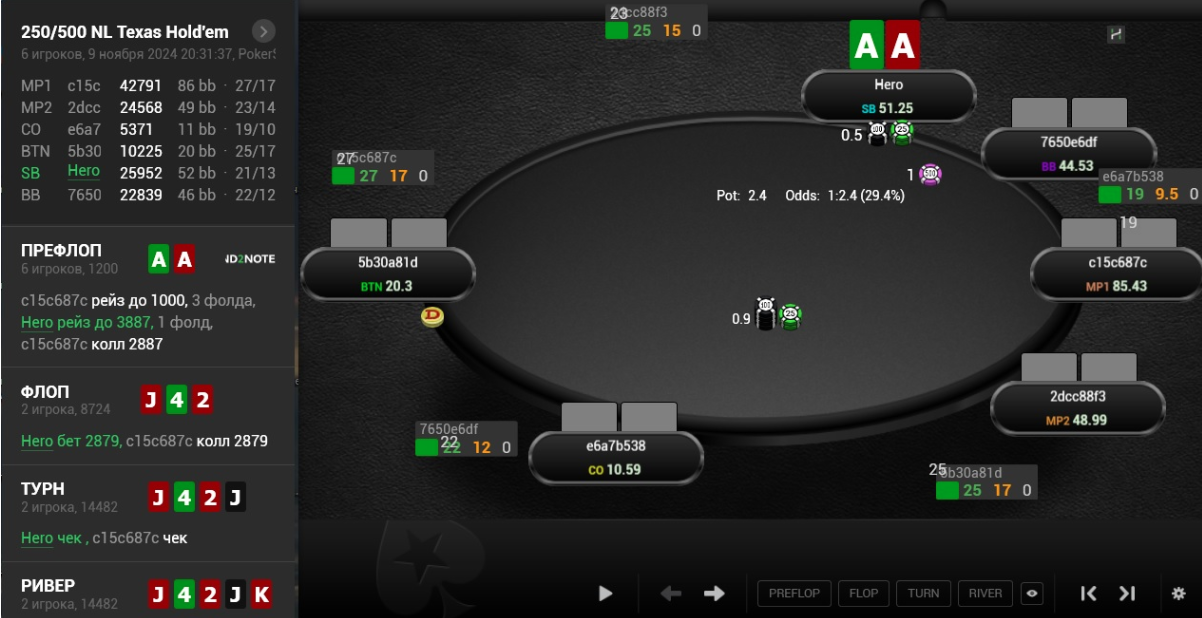
The screenshot above shows a rather curious spot. The beginning of the distribution is quite ordinary: chiro 3-betit with aces in the situation BB vs EP (effective stack 45 bb). On the board, we feel great with our hand and, of course, continue the game through cbet. Villain calls, and the thorn opens not the most pleasant runout -
.
Indeed, we can be wary of thrips from an opponent with hands such as KJs, JTs, J9s. Hiro checks and receives a return check from the EP opponent. River -, and the logical question arises, how is it better to play chiro here? river -, and the logical question arises, how Please note that after the checkback of the turn from our opponent, we are no longer very afraid that some Jx hands remain in his range. Now let's look at the situations with possible flushes.
In this hand, we see three excellent blockers for potential enemy flashes:
- The ace of hearts hiro blocks all possible nuts flushes.
- Jack of Hearts also blocks possible hands such as JQ, JT, J9.
- And finally, the worm king, who came out along the river, also prevents the formation of flushes with hands such as KT, KQ, K9.
In the distribution, Hiro waited and, having received the return check, looked at the opponent's pocket threes. After the analysis, the Velu Bet on the river suggests itself. We want to try here to get extract value from different Kx hands, such as KQ or AK (of course, we very much block AK, but even two blocker in our hand do not completely exclude such a hand from the possible). We can also get the extract value from such pocket pair as QQ or TT.
3. position at the table
Obviously, this is one of the key factors!
Let's say you're playing against a secret player in an early position. In this case, we can make a fairly accurate assumption that its opening range ranges from 15-17%. In fact, if the player is more nit, he will open even fewer hands, but we do not care in this case.
Let's take a look at such a range:
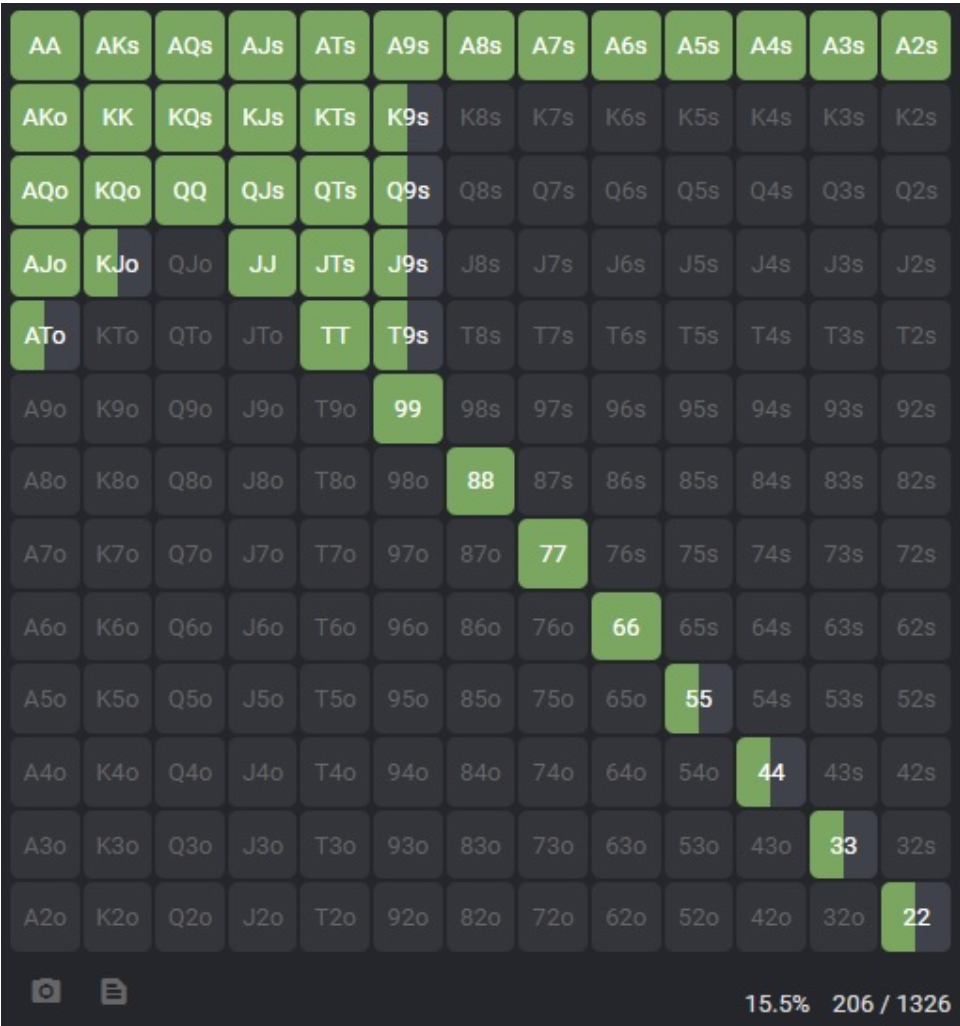
As we can see, the main part of the possible suite hands for the formation of flushes is a group of master aces. Let's say you just call on the big blind, and a 3-flush board comes out. This is a super dynamic board, but the above-described player with an EP has practically no ready-made flushes on such a board. Undoubtedly, a high coordinated board is quite suitable for a preflop aggressor, but for other reasons. He will have all the sets, strong doppers and good top pairs here. But from the ready-made flushes, we see only lonely ones
, and one combination of a royal flush with is also possible
.
For a better visual perception of the material, I transferred this range to the flopzilla and this is what happened.
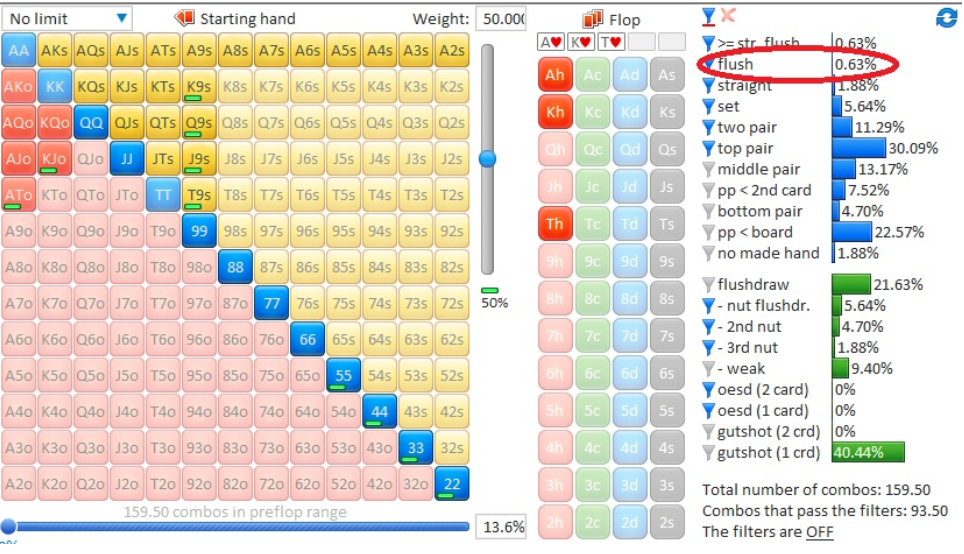
As we can see from this example, it is critically important to correctly assess the range against which you are playing.
4. Single-pots against the player on the big blind
The single pots, as such, include the usual raked spots, in which our villain will defend exclusively through a cold-call. Against an open-raise of a classic size of 2 bb, the big blind can protect any suited hand. This concept is well known and, more importantly, the field follows it. However, in percentage terms, many players, even in such situations, overestimate the number of closed flashes in the protection spectrum of the big blind.
Let's break down a fairly standard spot.
Middle stage of the tournament. Hiro opens 2bb with an HJ with a hand and gets a call from the big blind (BB). Effective 50bb stacks. Let's say an unknown player is playing against us (in principle, playing the MTT format, especially if you like to conquer kilopolyans, in most cases you will have to play against opponents who will not have reeds yet). The board comes out
. BB checks, and Hiro makes a cbet of 30% sweat. We get a call, and it comes on a thorn
. Villain is waiting again. Analyzing a lot of similar hands as a coach, I often see the following mistake. Many players tend to control pot here, so as not to overclock the pot on a 3-flash board.
This is fundamentally wrong, please note the screenshot below!
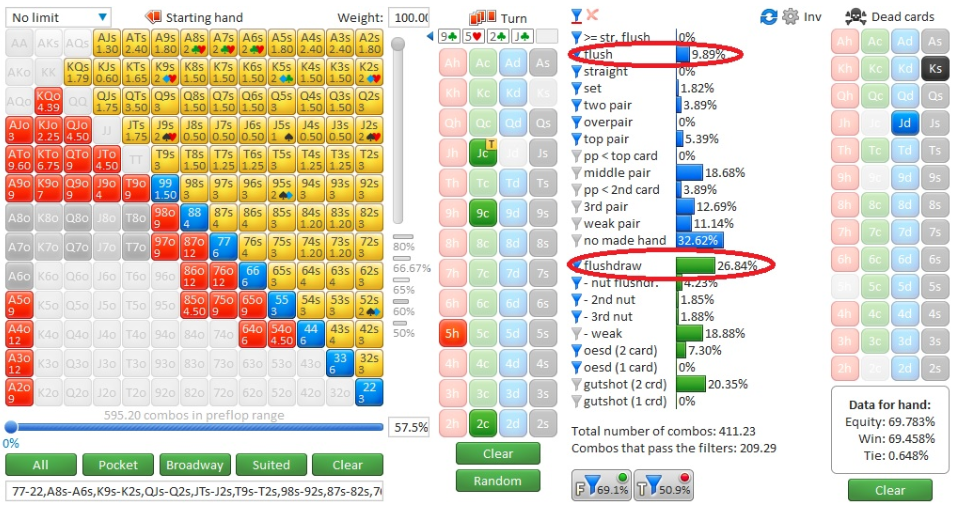
What do these metrics tell us?
After coming out on the tern in the expected range of our opponent, about 10% of the finished flushes. And at the same time, slightly less than 27% of potential flush draw. In such a situation, we always need to play through the second barrel! A tight bet on the turn will allow us to simultaneously protect our top pair and get a extract value from a large number of draw hands. That's why I always recommend doing such debriefings in Flopzilla. Looking at the above figures, Velu Bet becomes an intuitively obvious solution. Please note that in cases when we receive a check-raise on the turn, we will have every reason to reassess the range of the enemy, shifting it towards a strong valley: possible dopers, sets and, of course, ready-made flushes. And without regret to part with our top couple.
5. Potentially hazardous situations
These include, first of all, multipots, especially those in which you play against both blinds. This is partly due to the fact that the small blind also calls on the preflop a fairly significant part of the master hands.
The following groups can be distinguished:
- Masculine aces.
- Suited “broadway” maps.
- Suited connectors and hubs of 56s+, 57s+ format.
It is also worth noting that when playing on a 3-flush board, you should pay attention to blockers, which can be both general and personal in your hand. Play the multipots carefully, even if they don't have both blinds. I often tell my students: the more players in the bank, the higher the likelihood that someone will collect something strong.
6. aggression on flash runouts
In this section, we will talk about what to do if the outgoing woundout did not frighten, but on the contrary led to counter aggression on the part of your opponent.
Let's take a look at the situation in the screenshot below (the author of this hand is also one of my students).
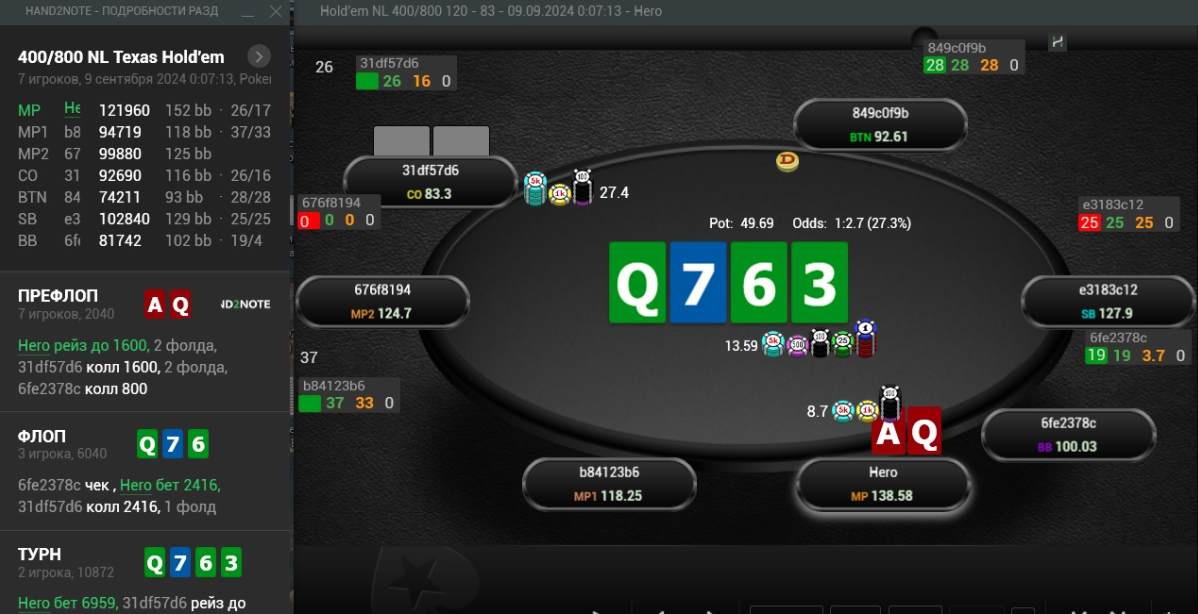
This hand was played in 100bb + deep stacks hand. Hiro opens with an EP min-raise with a hand. It is called CO and BB. On the flop,
we catch a top pair, and our cbet in such a situation is more than justified. Not the best card falls through the thorns -
. However, I still like the second barrel from Hiro. In poker, there are occasional situations in which you will not have an easy solution. In cases where you wait, it will be very difficult to understand where you are in the hand. In addition, on such a board, there are a considerable number of runouts that can almost completely devalue the equity of your hand.
- For example, any club card, as well as runouts such as 4 or 5 of any suit. Therefore, a bet sized half a pot or a little more seems to me quite a reasonable solution.
However, the player on CO responds with a raise. In general, when you encounter aggression on such runouts, you just have to lay down an extremely strong range for the raiser. You will rarely get a raise here from hands weaker than the set. Even though it is technically possible to find some beautiful half-bluffs with an ace of clubs in a player on the CO, it must be borne in mind that the field does not play such lines in most cases. Having disassembled the hand, we understand that bet/fold is an obvious decision on the turn.
7. Conclusion
In this article, we considered various situations with flash ranouts, in each of which we tried to find the optimal game and analyze common mistakes in order to become even stronger on the post-flop. I hope it worked. Good luck at the tables!





